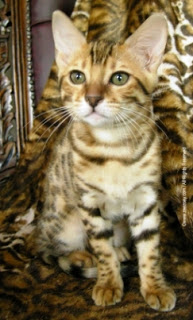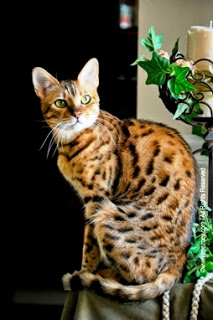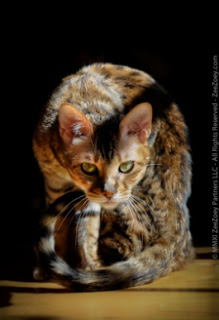Dogs
 By Deborah Barnes
By Deborah Barnes
It is no wonder the Bengal cat has taken the top spot as the number one most popular breed by TICA (The International Cat Association) for two years in a row. This miniature inspired leopard with its glossy coat and spotted fur is nothing less than stunning, and there is nothing ordinary about this breed whose claim to fame is a walk on the wild side.
It is for that very reason, that this cat also sparks some controversy and is not recognized as a registered breed with the CFA (Cat Fanciers Association). They consider this domesticated hybrid that descends from the Asian Leopard Cat to be “wild” (therefore with an unpredictable temperament) and that is why they don't accept the breed or allow it to be shown at CFA sanctioned shows.
The first Bengal was created in California in 1963 by an unplanned mating between a female Asian Leopard Cat and a domestic shorthair male. Fascinated with the concept, Jean Mill, the originator of the Bengal as we know it today, began a planned breeding program in 1980 to create a cat that looked like the Asian Leopard Cat, but had a domestic’s temperament. Leopard cats were originally bred to domestic shorthairs, Ocicats, Egyptian Maus, Abyssinian and Burmese, until the Bengal’s unique appearance of today was achieved.
The Bengal is a sleek and powerful cat with an athletic frame and a gait like its ancestors in the jungle – they prowl low to the ground with a fluidity of motion like a big cat in pursuit of prey. Despite that, because these remarkable creatures are a domesticated breed, they are actually very friendly and make a personable companion. They are amazing athletes, jumping two to three times higher than your typical cat, and are extremely intelligent, active, lively, graceful, strong, agile, curious and vocal.
 A Bengal comes in a variety of colors and patterns, each one equally as beautiful as the next. The shape of the head, ears, eyes, nose, neck, torso, tail, legs, feet, texture, color, pattern and contrast are typically what distinguishes a pet quality cat versus show or breeding quality. Accepted colors are brown tabby, seal lynx point, seal sepia tabby and seal mink tabby. The spots can be a splendid palette of blacks, rusts and cinnamons, and some Bengals possess a recessive “glitter gene” that gives the rosette pattern on the fur an iridescent glow, as if covered with warm frost. There are also silver and snow Bengal’s that have markings in whites, grays and blacks, or marbled Bengal’s in a unique scroll pattern that can be found in leopard or snow leopard colors.
A Bengal comes in a variety of colors and patterns, each one equally as beautiful as the next. The shape of the head, ears, eyes, nose, neck, torso, tail, legs, feet, texture, color, pattern and contrast are typically what distinguishes a pet quality cat versus show or breeding quality. Accepted colors are brown tabby, seal lynx point, seal sepia tabby and seal mink tabby. The spots can be a splendid palette of blacks, rusts and cinnamons, and some Bengals possess a recessive “glitter gene” that gives the rosette pattern on the fur an iridescent glow, as if covered with warm frost. There are also silver and snow Bengal’s that have markings in whites, grays and blacks, or marbled Bengal’s in a unique scroll pattern that can be found in leopard or snow leopard colors.
Bengals are classified in a range of generational types, from F1 to F4, with F1 cats being the closest to their wild ancestry, and F4 being the closest to the domestic. This changes the price and personality of the cat significantly and F1 cats should not be purchased without serious consideration, as they require informed owners who are equipped to take care of them and their special needs. They can be very difficult to socialize and tame, and do not always bond with a person as hoped or expected.
On the other hand, an F4 Bengal cat is generally very social and devoted to its family, forming strong, emotional bonds with their human friends. Because of this deep attachment and their high activity level, they need more human interaction than some other breeds. If you cannot handle an active cat or will be away from your home for prolonged periods of time, you should reconsider getting this breed. A Bengal must be provided with plenty of high spaces to safely jump up and down from, and can often be trained to perform tricks, as they are quick learners. They also enjoy water and take quite well to a harness and leash for walking outdoors.
 If you want a docile lap cat, this breed is probably not for you. Besides being extremely active, a Bengal can be a noisy cat, with a very loud and unique yelping, bleating kind of sound, along with a tendency to growl. This is merely a form a communication, as they enjoy a good conversation with their humans, but not everyone will find this trait endearing in the early morning hours. Bengals require little to no grooming and are a very healthy cat with the exception of a few who are prone to heart murmurs.
If you want a docile lap cat, this breed is probably not for you. Besides being extremely active, a Bengal can be a noisy cat, with a very loud and unique yelping, bleating kind of sound, along with a tendency to growl. This is merely a form a communication, as they enjoy a good conversation with their humans, but not everyone will find this trait endearing in the early morning hours. Bengals require little to no grooming and are a very healthy cat with the exception of a few who are prone to heart murmurs.
Deborah Barnes is the author of the book, The Chronicles of Zee & Zoey – A Journey of the Extraordinarily Ordinary, that was inspired by the relationship she shared with her family of seven cats and lessons learned from them after a life changing event in 2009. Among these cats is her beloved Bengal, Zoey, who she has been happily owned by since 2008 when she got her as a companion for her Maine Coon, Zee, who needed a high-energy playmate to share his day with.
Fitting in the palm of her hand when Deborah first got her, this free-spirited being brought instant joy and youth to her household that remains today. Zee fell head over heels in love with Zoey and the zest for life that she brings to everything she does – from randomly running full speed through the house to leaping atop every high spot she can find. Zoey is very petite cat, but has a personality the size of her jungle ancestors and she is the epitome of the storyline of the book she inspired. She takes every ordinary moment of life and dares to make it extraordinary. Then, just when you think she can’t entertain you anymore with her antics, she will snuggle up in the crook of your lap and peacefully nap with you for hours on end. That is a Bengal for you…
Top photo: It takes several years before the full deep coloring of a Bengal’s spots develop. In this photo, Zoey was about 12 weeks old, and you can see that her spots are very light and faded.
Middle photo: This is a Bengal in full glory with the colors fully developed. Zoey was about 3 years old in this photo, and she is stunning!
Bottom photo: This is the wild side of a Bengal – Zoey looks every bit the part of her ancestors!
- What Is The Smartest Cat Breed?
By Langley Cornwell It’s easier to measure a dog’s intelligence than a cat’s intelligence. I hope that statement doesn’t raise my cat-loving friends’ ire, but think about it: how do we measure a dog’s intelligence? Usually by noting how well...
- The Chronicles Of Zee & Zoey
By Julia Williams As a writer, books hold a special appeal to me. In a bookstore, I become the proverbial ‘kid in a candy store’ and can’t wait to sample them all. I love the feel of holding a book in my hands, love the way they smell and how the...
- Ocicats May Look Wild, But They’re Tame At Heart
By Julia Williams I vividly recall the first time I saw an Ocicat many years ago. I was at a cat show, and we were making the rounds looking at all of the different breeds. I stared at this exquisite spotted cat, certain that it wasn’t a domestic breed...
- The Most Beautiful Spotted Breeds Of Cat
Some cat breeds are hairless while others are shorthaired. There are also longhaired and curly breeds. If there are striped cat breeds there are also spotted cat breeds. Here they are the prettiest spotted breed of domestic cats… 1.) Manx Image Source ...
- Top 15 Lovely-looking Striped Breeds Of Cat In The World
Tigers and Zebras are the most popular striped animals in the world. If you are a cat lover, I am sure you are aware that there are breeds of cat that are striped. Here are the most beautiful and remarkable striped cat breeds in the world. 1.) Toyger...
Dogs
Taking a Walk on the Wild Side – The Bengal Breed

It is no wonder the Bengal cat has taken the top spot as the number one most popular breed by TICA (The International Cat Association) for two years in a row. This miniature inspired leopard with its glossy coat and spotted fur is nothing less than stunning, and there is nothing ordinary about this breed whose claim to fame is a walk on the wild side.
It is for that very reason, that this cat also sparks some controversy and is not recognized as a registered breed with the CFA (Cat Fanciers Association). They consider this domesticated hybrid that descends from the Asian Leopard Cat to be “wild” (therefore with an unpredictable temperament) and that is why they don't accept the breed or allow it to be shown at CFA sanctioned shows.
The first Bengal was created in California in 1963 by an unplanned mating between a female Asian Leopard Cat and a domestic shorthair male. Fascinated with the concept, Jean Mill, the originator of the Bengal as we know it today, began a planned breeding program in 1980 to create a cat that looked like the Asian Leopard Cat, but had a domestic’s temperament. Leopard cats were originally bred to domestic shorthairs, Ocicats, Egyptian Maus, Abyssinian and Burmese, until the Bengal’s unique appearance of today was achieved.
The Bengal is a sleek and powerful cat with an athletic frame and a gait like its ancestors in the jungle – they prowl low to the ground with a fluidity of motion like a big cat in pursuit of prey. Despite that, because these remarkable creatures are a domesticated breed, they are actually very friendly and make a personable companion. They are amazing athletes, jumping two to three times higher than your typical cat, and are extremely intelligent, active, lively, graceful, strong, agile, curious and vocal.

Bengals are classified in a range of generational types, from F1 to F4, with F1 cats being the closest to their wild ancestry, and F4 being the closest to the domestic. This changes the price and personality of the cat significantly and F1 cats should not be purchased without serious consideration, as they require informed owners who are equipped to take care of them and their special needs. They can be very difficult to socialize and tame, and do not always bond with a person as hoped or expected.
On the other hand, an F4 Bengal cat is generally very social and devoted to its family, forming strong, emotional bonds with their human friends. Because of this deep attachment and their high activity level, they need more human interaction than some other breeds. If you cannot handle an active cat or will be away from your home for prolonged periods of time, you should reconsider getting this breed. A Bengal must be provided with plenty of high spaces to safely jump up and down from, and can often be trained to perform tricks, as they are quick learners. They also enjoy water and take quite well to a harness and leash for walking outdoors.

Deborah Barnes is the author of the book, The Chronicles of Zee & Zoey – A Journey of the Extraordinarily Ordinary, that was inspired by the relationship she shared with her family of seven cats and lessons learned from them after a life changing event in 2009. Among these cats is her beloved Bengal, Zoey, who she has been happily owned by since 2008 when she got her as a companion for her Maine Coon, Zee, who needed a high-energy playmate to share his day with.
Fitting in the palm of her hand when Deborah first got her, this free-spirited being brought instant joy and youth to her household that remains today. Zee fell head over heels in love with Zoey and the zest for life that she brings to everything she does – from randomly running full speed through the house to leaping atop every high spot she can find. Zoey is very petite cat, but has a personality the size of her jungle ancestors and she is the epitome of the storyline of the book she inspired. She takes every ordinary moment of life and dares to make it extraordinary. Then, just when you think she can’t entertain you anymore with her antics, she will snuggle up in the crook of your lap and peacefully nap with you for hours on end. That is a Bengal for you…
Top photo: It takes several years before the full deep coloring of a Bengal’s spots develop. In this photo, Zoey was about 12 weeks old, and you can see that her spots are very light and faded.
Middle photo: This is a Bengal in full glory with the colors fully developed. Zoey was about 3 years old in this photo, and she is stunning!
Bottom photo: This is the wild side of a Bengal – Zoey looks every bit the part of her ancestors!
- What Is The Smartest Cat Breed?
By Langley Cornwell It’s easier to measure a dog’s intelligence than a cat’s intelligence. I hope that statement doesn’t raise my cat-loving friends’ ire, but think about it: how do we measure a dog’s intelligence? Usually by noting how well...
- The Chronicles Of Zee & Zoey
By Julia Williams As a writer, books hold a special appeal to me. In a bookstore, I become the proverbial ‘kid in a candy store’ and can’t wait to sample them all. I love the feel of holding a book in my hands, love the way they smell and how the...
- Ocicats May Look Wild, But They’re Tame At Heart
By Julia Williams I vividly recall the first time I saw an Ocicat many years ago. I was at a cat show, and we were making the rounds looking at all of the different breeds. I stared at this exquisite spotted cat, certain that it wasn’t a domestic breed...
- The Most Beautiful Spotted Breeds Of Cat
Some cat breeds are hairless while others are shorthaired. There are also longhaired and curly breeds. If there are striped cat breeds there are also spotted cat breeds. Here they are the prettiest spotted breed of domestic cats… 1.) Manx Image Source ...
- Top 15 Lovely-looking Striped Breeds Of Cat In The World
Tigers and Zebras are the most popular striped animals in the world. If you are a cat lover, I am sure you are aware that there are breeds of cat that are striped. Here are the most beautiful and remarkable striped cat breeds in the world. 1.) Toyger...
